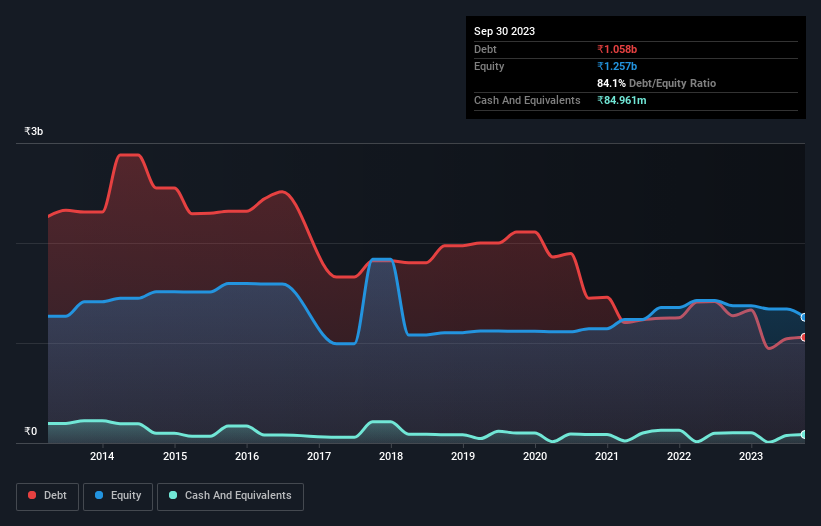
David Iben put it well when he said, 'Volatility is not a risk we care about. What we care about is avoiding the permanent loss of capital.' When we think about how risky a company is, we always like to look at its use of debt, since debt overload can lead to ruin. We can see that Shiva Texyarn Limited (NSE:SHIVATEX) does use debt in its business. But should shareholders be worried about its use of debt?
When Is Debt Dangerous?
Debt assists a business until the business has trouble paying it off, either with new capital or with free cash flow. Ultimately, if the company can't fulfill its legal obligations to repay debt, shareholders could walk away with nothing. However, a more common (but still painful) scenario is that it has to raise new equity capital at a low price, thus permanently diluting shareholders. Of course, debt can be an important tool in businesses, particularly capital heavy businesses. The first thing to do when considering how much debt a business uses is to look at its cash and debt together.
See our latest analysis for Shiva Texyarn
How Much Debt Does Shiva Texyarn Carry?
As you can see below, Shiva Texyarn had ₹1.06b of debt at September 2023, down from ₹1.27b a year prior. However, it does have ₹85.0m in cash offsetting this, leading to net debt of about ₹972.7m.

How Strong Is Shiva Texyarn's Balance Sheet?
The latest balance sheet data shows that Shiva Texyarn had liabilities of ₹1.13b due within a year, and liabilities of ₹769.6m falling due after that. Offsetting these obligations, it had cash of ₹85.0m as well as receivables valued at ₹389.6m due within 12 months. So its liabilities outweigh the sum of its cash and (near-term) receivables by ₹1.42b.
This deficit is considerable relative to its market capitalization of ₹2.18b, so it does suggest shareholders should keep an eye on Shiva Texyarn's use of debt. Should its lenders demand that it shore up the balance sheet, shareholders would likely face severe dilution. There's no doubt that we learn most about debt from the balance sheet. But it is Shiva Texyarn's earnings that will influence how the balance sheet holds up in the future. So if you're keen to discover more about its earnings, it might be worth checking out this graph of its long term earnings trend.
In the last year Shiva Texyarn had a loss before interest and tax, and actually shrunk its revenue by 23%, to ₹3.8b. That makes us nervous, to say the least.
Caveat Emptor
Not only did Shiva Texyarn's revenue slip over the last twelve months, but it also produced negative earnings before interest and tax (EBIT). To be specific the EBIT loss came in at ₹100m. When we look at that and recall the liabilities on its balance sheet, relative to cash, it seems unwise to us for the company to have any debt. Quite frankly we think the balance sheet is far from match-fit, although it could be improved with time. For example, we would not want to see a repeat of last year's loss of ₹115m. So to be blunt we do think it is risky. The balance sheet is clearly the area to focus on when you are analysing debt. But ultimately, every company can contain risks that exist outside of the balance sheet. For example, we've discovered 4 warning signs for Shiva Texyarn (1 can't be ignored!) that you should be aware of before investing here.
When all is said and done, sometimes its easier to focus on companies that don't even need debt. Readers can access a list of growth stocks with zero net debt 100% free, right now.
New: Manage All Your Stock Portfolios in One Place
We've created the ultimate portfolio companion for stock investors, and it's free.
• Connect an unlimited number of Portfolios and see your total in one currency
• Be alerted to new Warning Signs or Risks via email or mobile
• Track the Fair Value of your stocks
Have feedback on this article? Concerned about the content? Get in touch with us directly. Alternatively, email editorial-team (at) simplywallst.com.
This article by Simply Wall St is general in nature. We provide commentary based on historical data and analyst forecasts only using an unbiased methodology and our articles are not intended to be financial advice. It does not constitute a recommendation to buy or sell any stock, and does not take account of your objectives, or your financial situation. We aim to bring you long-term focused analysis driven by fundamental data. Note that our analysis may not factor in the latest price-sensitive company announcements or qualitative material. Simply Wall St has no position in any stocks mentioned.
About NSEI:SHIVATEX
Shiva Texyarn
Manufactures and sells cotton yarn, coated and laminated fabrics, home textiles, and other value-added textile products in India and internationally.
Slight with mediocre balance sheet.
Similar Companies
Market Insights
Community Narratives



